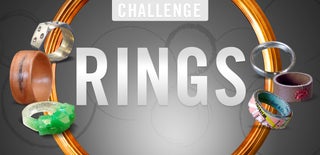Introduction: How to Make an Ear Ring (a Ring That Is an Ear) 3D Printing
I am an Audioprosthologist (test hearing and fit hearing aids) and am working towards a doctorate in Audiology. I thought it would be fun to make an "ear ring" that didn't make a man look like an effeminate pirate when wearing it :)
All parts of the ring are 3D printed with a Printrbot Simple Metal 3D Printer using 2 different free objects from Thingiverse. I will share my settings and info from my 3D printing, but your settings may vary depending on your software/machine/filament etc...
Step 1: 3D Printing Parts
The Ear
The model for the ear can be found at http://www.thingiverse.com/thing:304657. As you can see from the screen shot, I scaled the ear down with my printer software (I am using Cura). I scaled the "X" to 23mm (and the other dimensions automatically constrained to the proportions). Also, notice that I took my print speed down to 20 (could have gone a little slower probably, but it did fine at 20 mm/second). With something this small, you'll want to slow down a bit to keep the details sharper. I also chose my highest resolution (my machine does 100 microns) and set the fill density to 100%. I didn't bother with any support material as the bottom of the ear supplies a nice flat surface to adhere to the build plate. I am using skin colored PLA filament (found it on ebay for a 1/5kg for around $12 shipped), and I have found that it seems to print well at around 195 celsius. Again, all of this may change with your settings and filament color type you use.
The Ring
The model for the ring can be found at http://www.thingiverse.com/thing:167081. I didn't scale the ring at all, just printed at 100%. I'm a bigger guy and it fits on my pinky finger nicely, but I can't get it on my ring finger (I may make a new one that I scale up a few mm to fit my ring ringer, and I would just scale the ear up proportionally). It fits loosely on my wife's index finger though, so it could also be scaled down if needed the same way. You'll notice that I added a brim support on the ring (just to make sure it didn't topple over during printing, it probably would have been ok without it though). I kept the other settings from the ear the same (fill density at 100%, speed to 20 mm/second, layer height to 100 microns etc...). I did have to rotate the ring so that the flat side was facing down on the build plate as it will print better in that orientation, but other than that I didn't have to do anything to that model.
Step 2: Finishing the Ring
After printing, the pieces had a few little rough edges and stringy strands from bridging in a few areas. I used a dremel tool with a sanding drum to hit the big stuff first, and then I used a sheet of 180 grit hand sandpaper to smooth everything out. I find that if you try to do too much with the dremel, it ends up melting more than sanding at that high speed. You really get better results if you also use hand sand paper to finish.
After everything was as smooth as I wanted it, I put a few drops of super glue on the ear, and placed it on the ring. Make sure and get it placed on right quickly because it sticks pretty quick once you place the pieces together. I then took the hand sand paper and smoothed out the seems and transitions from the ear to the ring. The filament dust actually ends up getting in the cracks and mixing with the super glue a bit and making a nice "plastic" filler for the seem.
Step 3: Finished Ring
Here is the ring all finished and ready to adorn my hairy knuckle. I will end up giving this as a gag gift at work or school. It was fun to make and turned out great with the skin colored filament. I have used the same model of the ear to make cuff links too, and next time I make a set will try to grab pics for an instructable. If you liked this guide, please vote for it in the contests.

First Prize in the
CNC Challenge

First Prize in the
Rings Challenge













